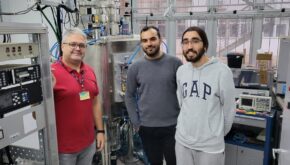Champion in ethanol production, Brazil has advantages in the green hydrogen era
0 minutos de leitura
Clean fuel produced from sugarcane biomass has high hydrogen content and does not require adaptations in the distribution infrastructure.
An international highlight in the production of ethanol, made from sugarcane, Brazil can enter the green hydrogen era faster. The liquid fuel, used to fuel vehicle engines for at least four decades in the country, is a kind of biomass with high content of hydrogen. The secret is in chemistry: each molecule of ethanol has three hydrogen atoms for each carbon atom. It’s almost twice what gasoline has (1.62 hydrogen atom for each carbon atom), Plínio Nastari, president of the Brazilian Institute of Bioeconomics (IBIO), explains.
“Brazil is a champion: there is no other country that can compare to its activity in this area”, Nastari states. “And extracting green hydrogen from ethanol, a renewable energy source, is perfectly possible”, he completes.
One of the paths pointed out by Nastari is the electrification of this biomass in the mobility area. That is, green hydrogen can be extracted from ethanol, which nowadays fuels 48% of the national fleet, to power up electric vehicles. The transformation takes place in a fuel cell installed on the car itself. The component named as reformer makes the separation of the hydrogen contained in the ethanol molecule. Afterwards, another component, the reactor, converts the hydrogen into electricity, which, in turn, fuels the engine.
“The assemblers have been referring to Brazil as a country that has already solved the infrastructure issues for green hydrogen for having the entire ethanol infrastructure already installed”, the president of IBIO, who was a member of the National Council for Energy Policy as a representative of the civil society from 2016 to 2020, points out. In the full national territory, the more than 42 thousand fuel stations would not need any adaptation to supply ethanol to the fleet powered by green hydrogen.
“Our goal is to focus on the hydrogen obtained from ethanol”, Edmundo Barbosa, president of Sindalcool Paraíba, confirms Plinio Nestari’s perspective. In Barbosa’s opinion, obtaining H2 by means of electrolysis is complex at this moment due to the difficult moment caused by the water crisis. Another option for converting biomass into green hydrogen involves biological processes that involve biogas and biomethane. In Brazil, on the other hand, this is a path yet to be taken, Barbosa mentions. “Germany has 12 thousand biogas and biomethane facilities”, Barbosa says, for comparison purposes. “This is a great lode and it will be explored in the next years, as biomethane is currently one of the biofuels encouraged by the national biofuels policy in the country”, he adds.
Biomethane is evaluated as an excelent form of the residue that currently leaves the plants, which is sugarcane vinasse. The by-product is utilized in fertigation, however, in Barbosa’s opinion, it could be even better utilized for obtaining biogas and biomethane. “We want to export H2V to Germany and the European Union. This is our focus. The ethanol plants will be able to provide green hydrogen to the steel industry and to other industries, thus avoiding the huge CO2 emissions from both natural gas and other fossil sources”, Barbosa argues.
According to Ansgar Pinkowski, manager of Innovation and Sustainability and Business Scout for Development of the German-Brazilian Chamber of Commerce and Industry (AHK Rio), the use of biomass can be an excellent national technological route for producing hydrogen. This way, the country would be able to utilize all of its excellent capacity to produce green hydrogen, through electrolysis, to serve other countries and become an important player in this new market. Pinkowski also highlights that the increasing demand from the internal market could be met by means of the hydrogen obtained from biomass. “And maybe in a near future, Brazil can develop technologies that can be exported to other countries, being based on the long tradition of ethanol production and use”, he adds.
This is one of the reasons that led Adalberto Arruda, an environmental lawyer, to take the debate to the sugar and ethanol sector in Pernambuco. The state is the second in the Northeastern region in sugarcane production, with 11.7 million tons in the 2020/2021 harvest. “The subject of green hydrogen from ethanol began to be considered by the sector, which finds it interesting. I see good chances for us to objectively advance in this goal”, Arruda stated.


